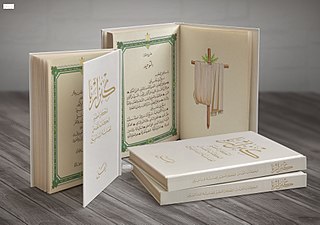
The Ginza Rabba, Ginza Rba, or Sidra Rabba, and formerly the Codex Nasaraeus, is the longest and the most important holy scripture of Mandaeism.
Krun or Akrun is a Mandaean lord of the underworld. According to Mandaean cosmology, he dwells in the lowest depths of creation, supporting the entirety of the physical world.
In Mandaeism, ṣauma is a term that means fasting. Although ṣauma can refer to physical fasting, it is more often used in Mandaeism to refer to spiritual piety and abstaining from sin.
In Mandaeism, Rūha is the queen of the World of Darkness or underworld. She rules the underworld together with her son Ur, the king of the World of Darkness, and her entourage of the seven planets and twelve constellations, who are also her offspring with Ur.
In Mandaeism, Kiwan, Kiuan, or Kewan is the Mandaic name for the planet Saturn. Kiwan is one of the seven planets, who are part of the entourage of Ruha in the World of Darkness.
An uthra or ʿutra is a "divine messenger of the light" in Mandaeism. Charles G. Häberl and James F. McGrath translate it as "excellency". Jorunn Jacobsen Buckley defines them as "Lightworld beings, called 'utras ." Aldihisi (2008) compares them to the yazata of Zoroastrianism. According to E. S. Drower, "an 'uthra is an ethereal being, a spirit of light and Life."
In Mandaeism, ʿUr is the king of the World of Darkness or underworld. He is the son of Ruha, the queen of the underworld, and her brother Gaf, one of the giants in the World of Darkness described in book 5 of the Ginza Rabba. Ur is typically portrayed as a large, ferocious dragon or snake. He is represented by the image of a serpent on the skandola talisman.
Mandaean cosmology is the Gnostic conception of the universe in the religion of Mandaeism.
The Mandaean calendar is a 365-day solar calendar used by the Mandaean people. It consists of twelve 30-day months, with five extra days at the end of Šumbulta. The Parwanaya festival takes place during those five days. There is no leap year therefore every four years all Mandaean dates move one day back with respect to the Gregorian calendar.
In Mandaeism, the World of Darkness is the underworld located below Tibil (Earth). It is ruled by its king Ur the Leviathan and its queen Ruha, mother of the seven planets and twelve constellations.
In Mandaeism, Shishlam is a figure representing the prototypical Mandaean priest or Mandaean. He is also frequently referred to in Mandaean texts as Šišlam Rabba (Classical Mandaic: ࡔࡉࡔࡋࡀࡌ ࡓࡁࡀ, romanized: Šišlam Rba, lit. 'Great Shishlam'. Shishlam is sometimes identified with Adam Kasia, the "Perfect Man".
In Mandaeism, Hag and Mag are a pair of demons that are usually mentioned together. Hag is a male demon, while Mag is a female demon. Hibil Ziwa encounters Hag and Mag during his descent to the World of Darkness in Chapter 1 of Book 5 in the Right Ginza, where they are described as "the two manas of darkness." Hag is represented by the image of a scorpion on the skandola talisman.
In Mandaeism, Anush or Anush Uthra is an uthra from the World of Light. Anush is considered to be the Mandaean equivalent of Enos.

In Mandaeism, the bshuma is a religious formula that is often written at the beginnings of chapters in Mandaean texts and prayers. The Islamic equivalent is the basmala.
In Mandaeism, ʿNbu, Nbu, or Enbu is the Mandaic name for the planet Mercury. Nbu is one of the seven planets, who are part of the entourage of Ruha in the World of Darkness. This name was borrowed from the Mesopotamian god called Nabu.
In Mandaeism, Bil or Bel is the Mandaic name for the planet Jupiter. Bil is one of the seven planets, who are part of the entourage of Ruha in the World of Darkness.
In Mandaeism, Sin or Sen is the Mandaic name for the Moon. Sin is one of the seven planets, who are part of the entourage of Ruha in the World of Darkness.
In Mandaeism, Shamish or Šamiš is the Mandaic name for the Sun. Shamish is one of the seven classical planets, who are part of the entourage of Ruha in the World of Darkness.
In Mandaeism, Libat is the Mandaic name for the planet Venus. Libat is one of the seven planets, who are part of the entourage of Ruha in the World of Darkness.
In Mandaeism, Jesus or Mšiha is mentioned in Mandaean texts such as the Ginza Rabba, Mandaean Book of John, and Haran Gawaita.



